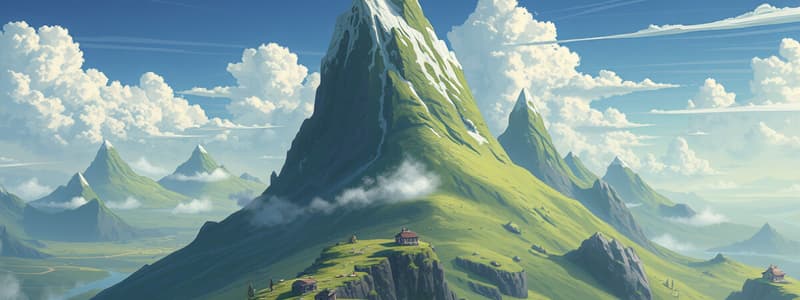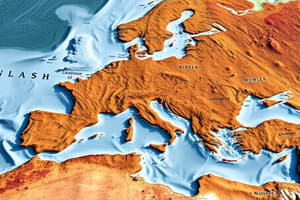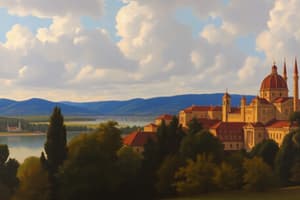Podcast
Questions and Answers
What is geography?
What is geography?
- The study of the earth's physical structure and history
- Study of where people, places, and things are located (ways in which things relate to each other) (correct)
- The difference between the highest and lowest points
- None of the above
What is absolute location?
What is absolute location?
- It is the distance around the globe
- Where it is located in relation to other places
- It is the position on the globe (correct)
- None of the above
What is the Equator?
What is the Equator?
- Is one such line (correct)
- The earth's outer shell
- Two lines that go around the earth
- None of the above
What does the Prime Meridian run through?
What does the Prime Meridian run through?
What is latitude?
What is latitude?
What is longitude?
What is longitude?
What is a plate tectonic?
What is a plate tectonic?
How many themes of Geography are there?
How many themes of Geography are there?
What is lava?
What is lava?
What is the difference between lava and magma?
What is the difference between lava and magma?
What is the core?
What is the core?
What comes first?
What comes first?
What is a continent?
What is a continent?
Who started the continental drift theory?
Who started the continental drift theory?
What makes the Ring of Fire?
What makes the Ring of Fire?
What is the earth's crust like?
What is the earth's crust like?
What is a fold?
What is a fold?
What is a fault?
What is a fault?
What is the mantle?
What is the mantle?
What is geology?
What is geology?
Flashcards are hidden until you start studying
Study Notes
Geography and Location
- Geography examines the Earth's physical structure, history, and the relationships among people, places, and things.
- Absolute location refers to a specific point on the globe, pinpointed by coordinates; it differs from relative location, which describes a place's location in relation to others.
- The Equator is an important imaginary line that divides the Earth into northern and southern hemispheres.
- The Prime Meridian, running through the Royal Observatory in England, marks the starting point for measuring longitude.
Latitude and Longitude
- Latitude lines are parallel to the Equator and measure distance north or south.
- Longitude lines, on the other hand, run from the North Pole to the South Pole and measure distance east or west.
Tectonic Activity
- Plate tectonics refers to large, moving pieces of the Earth's crust that can cause earthquakes and volcanic activity.
- Understanding plate tectonics is essential for comprehending geological processes and earth's changing landscape.
Geological Terms
- Lava is molten rock expelled during a volcanic eruption, while magma is the molten rock found beneath the Earth's crust.
- The Earth's core is its innermost layer, situated at the center of the Earth.
- The mantle is a thick, solid rock layer surrounding the core, impacting geological dynamics and tectonic movements.
Continents and Geography Theories
- There are seven continents: Asia, Antarctica, Europe, Africa, Australia, North America, and South America.
- The continental drift theory, which explains the movement of continents, was proposed by Alfred Wegener.
Geographical Features
- The "Ring of Fire" is a region characterized by a circle of volcanoes surrounding the Pacific Ocean, significant for its seismic and volcanic activity.
- Geological features include folds (bends in the Earth's crust) and faults (fractures or breaks in the crust), both critical in understanding Earth's geological structure.
Study of Earth
- Geology focuses on studying the Earth’s physical structure and history, while geography studies spatial relationships of places and environments.
Studying That Suits You
Use AI to generate personalized quizzes and flashcards to suit your learning preferences.




